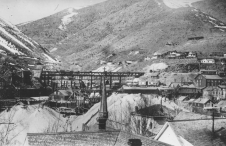Hamilton and Treasure Hill
A mineral strike in January 1867 resulted in the "White Pine Excitement" and the founding of Treasure City (originally Tesora) perched on Treasure Hill. Silver ore assayed at as much as $15,000 per ton. The astounding figure was over three times greater than some of the best ore from the Comstock Lode, which was slumping into a depression in the late 1860s. A rush to the region depleted the population in other mining towns including Virginia City and Austin.
Several communities came into existence in answer to the influx of fortune seekers, but Hamilton, founded in 1868, was the most significant. The well-situated town acted as a commercial hub for the mining district. By 1869, estimates placed its population as high as ten thousand people. That year, engineers completed an ambitious water project designed to serve fifty thousand people and costing almost $400,000.
Because of the region's sudden growth, the state legislature created White Pine County in 1869, designating Hamilton as the seat of government. By the following year, the town had a $55,000 courthouse. Treasure City at a colder, higher elevation was not as well placed to function as an entrepreneurial focal point. Nevertheless, this center of mining became home to several thousand as reports of mineral wealth spread throughout the West. Together with many smaller settlements scattered about the expansive mining district, both communities thrived with businesses, mills, and excavations.
Unfortunately, miners quickly depleted the region's rich but limited ore bodies. Mines were failing by 1870, and people left for better prospects. That year, Treasure City shrank to fewer than five hundred people. Hamilton's population was less than four thousand, a figure that diminished to five hundred three years later. By the end of the 1870s, Hamilton's economy depended almost entirely on county government. Only a few people remained in Treasure City.
An 1880 rush to Cherry Creek, northeast of Hamilton, resulted in a rival community's prosperity. Cherry Creek residents began calling for a shift in the seat of county government. Hamilton fended off the move largely because there were several contenders vying for the honor. Their dissension left Hamilton in a tenuous position of power. In 1885, however, Hamilton's courthouse burned. With no reason to invest in public architecture in a community so poorly located, the commissioners eventually moved their government to Ely, selected partly because of its central location.
Deprived of its last industry, Hamilton declined into oblivion. A limited revival in the 1920s brought Treasure Hill back to life, but it declined once again within a few years. For decades Hamilton was one of Nevada's finest ghost towns. But in the 1960s and 70s, vandals and thieves stripped the old county seat of its buildings and artifacts, leaving little to remind visitors of the town's short-lived glory.
Article Locations
Related Articles
Further Reading
None at this time.



